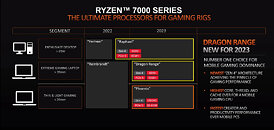- Joined
- Oct 9, 2007
- Messages
- 47,668 (7.43/day)
- Location
- Dublin, Ireland
| System Name | RBMK-1000 |
|---|---|
| Processor | AMD Ryzen 7 5700G |
| Motherboard | Gigabyte B550 AORUS Elite V2 |
| Cooling | DeepCool Gammax L240 V2 |
| Memory | 2x 16GB DDR4-3200 |
| Video Card(s) | Galax RTX 4070 Ti EX |
| Storage | Samsung 990 1TB |
| Display(s) | BenQ 1440p 60 Hz 27-inch |
| Case | Corsair Carbide 100R |
| Audio Device(s) | ASUS SupremeFX S1220A |
| Power Supply | Cooler Master MWE Gold 650W |
| Mouse | ASUS ROG Strix Impact |
| Keyboard | Gamdias Hermes E2 |
| Software | Windows 11 Pro |
AMD is planning a massive integrated graphics performance uplift for its next-generation Ryzen 7000U mobile processors. Codenamed "Phoenix," this SoC will feature a CPU based on the "Zen 4" microarchitecture with a higher CPU core count than the Intel alternative of the time; and an iGPU based on the RDNA3 graphics architecture. AMD is planning to endow this with the right combination of a CU count and engine clocks, to result in performance that roughly matches the NVIDIA GeForce RTX 3060 Laptop GPU, a popular performance-segment discrete GPU for notebooks, according to greymon55. Other highlights of "Phoenix" include a DDR5 + LPDDR5 memory interface, and PCI-Express Gen 5. The SoC is expected to be built on the TSMC N5 (5 nm) process, and debut in 2023.

View at TechPowerUp Main Site | Source

View at TechPowerUp Main Site | Source




